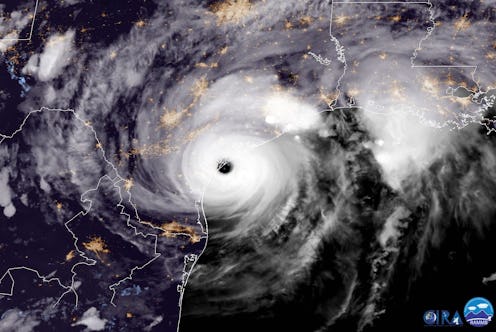
After making its way through coastal Texas, Hurricane Harvey was downgraded to a tropical storm around 12 P.M. CDT Saturday, according to a report from CNN. The storm made landfall around 10 P.M. CDT last night. The National Weather Service predicted that it could maintain tropical storm status through Monday. Though the storm is now much less dangerous than it was when it originally touched down as a Category 4 hurricane, Harvey still poses a huge threat to Texas as it makes its way north.
When predictions about the hurricane initially began to surface, some commentators feared that it might be as bad as Hurricane Katrina, which devastated Louisiana and killed over 1,000 people. At present, the storm has fortunately not created the same kind of damage that Americans saw unfold back in 2005. Texas Governor Greg Abbott said at a press conference that there are currently over 330,000 power outages across the affected region, and that repair crews can't operate until wind speeds die down, the Guardian reported. The current biggest risk, Gov. Abbot added, was flooding, as there could be up to 40 inches of rain in some parts of the state, especially if the storm continues to rage through the beginning of the week.
A tropical storm, though less intense than a full-blown hurricane, is still wildly dangerous. Tropical storms are defined by having sustained winds of 39 m.p.h. to 73 m.p.h., according to the National Hurricane Center. Coupled with the risk of flooding could mean deep devastation, especially in locations that weren't prepared for the storm's turbulence.
In the press conference as reported by the New York Times, Gov. Abbot warned that flood waters were often deeper than they looked, and could have faster currents than expected. “Turn around, don’t drown. Don’t risk your life,” he said. “The most important thing all Texans can do is to put your life and the protection of your life first and foremost.” According to the government's hurricane preparedness website, just six inches of fast-moving water can knock down a full-grown person. That water can obscure downed power lines or fast-moving debris that could incapacitate you.
For residents who have not evacuated areas that will see the majority of Tropical Storm Harvey's force, experts advise remaining indoors and away from windows, turning your refrigerator's temperature setting to the coldest setting and opening only when necessary (if you have yet to lose power), and continuing to monitor the situation.
For the rest of us who are watching the storm's progress from afar, Bustle rounded up a few ways to help support victims of the storm in Rockport, TX, which has already sustained an enormous amount of damage. GoFundMe has also aggregated a list of all the different campaigns created to assist victims of the storm. There are many ways to help, and more to come as damage from the storm is assessed in full.